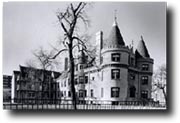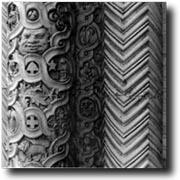 |
|

This mansion at 4938 Drexel Boulevard
was built in 1890 for physician John A. McGill. The building,
notes Julius Lewis, is “one of Cobb’s biggest, if
not most successful, houses. The gray stone, French Renaissance
design echoes the University of Chicago buildings” a
few blocks to the south. The architectural references to a
castle may, Lewis speculates, be a result of the owner’s
wishes.
|
Beginning his career at a time when there were probably no more
than 30 U.S. architects who had received any formal training—either
in the U.S. or abroad—Cobb was an obvious choice for clients
seeking architects with an understanding of historicism, the borrowing
and transforming of previous architectural idioms.
Although Cobb worked in the midst of an architectural revolution,
his own contributions were more stylistic than structural. And his
best work, says Lewis, came not in the the University of Chicago’s
Oxford–inspired quadrangles. Designing buildings to meet “a
demand for Gothic,” Lewis notes, “his campus buildings
are about as Gothic as the Reliance Building,” a Loop monument
to modernity. He pauses, reconsiders: “Still, the buildings
are gray, and they do have gargoyles and grotesques.”
|

Cobb’s fondness for ornamentation
rooted in classical mythology is evident in this detail from
a pillar at Yerkes Observatory. Each pillar consists of three
stacked sets of the same designs—incorporating real and
imaginary animals, signs of the zodiac, phases of the moon,
and a caricature of the University’s first president,
William Rainey Harper.
|
Cobb’s best work, Lewis continues, was done in Chicago and
in the Romanesque revival idiom first made famous by H. H. Richardson.
Used for residences, clubs, and commercial buildings well into the
1890s, Richardsonian Romanesque buildings often featured heavy,
rough-cut stone walls, rounded arches and squat columns, deeply
recessed windows, and pressed metal bays and turrets. With a natural
talent for ornamental drawing, Cobb delighted in adding fancifully
elaborate detail—whether the aquatic figures decorating his
Fisheries Building for the Columbian Exposition, the playful grotesques
on the Chicago quadrangles, or the celestial imagery at Yerkes Observatory
in Williams Bay, Wisconsin.
In 1898, Cobb left Chicago for Washington, D.C. (though he maintained
an office in Chicago for several years after the move). With his
national reputation—he had won commissions for banks, residences,
and office buildings all over the country—he may have gone
east for his children’s health. But it’s also likely,
says Lewis, that he was “chasing important work in Washington,”
especially in light of a construction slump that hit Chicago following
the panic of 1893.
In fact, after 1898, when the bulk of his work for the University
was done, Cobb designed only two buildings of importance in Chicago—the
Dutch Renaissance–inspired warehouse and office building at
Dearborn and Kinzie that now houses Harry Caray’s Restaurant,
and the Chicago Post Office and Federal Building. “The old
Post Office” occupied an entire block (between Dearborn and
Clark Streets and Adams and Jackson Streets) until 1965, when it
was torn down and replaced by a federal complex.
Once in Washington, the work Cobb sought—a chance to repeat
his U of C experience by creating a campus for the new American
University—never materialized. Asked to design only one building
for the new university, he soon moved on to New York City. There
his work included both office buildings and residences. He was active
as an architect until his death in 1931. Lewis says he and Daniel
are “hot on the trail” of several of Cobb’s New York
houses, but the record is sparse, partly because he was no longer
getting the day’s biggest commissions. “After he left
Chicago, Cobb declined,” Lewis says, “both in terms of
popularity and in the quality of his work.”
Perhaps the most important reason for Cobb’s decline, explains
Lewis, was that, as architectural styles changed, he began “to
be perceived as old-fashioned. After the Columbian Exposition in
the Midwest, and even before in the East, there was a great hunger
for Beaux Arts buildings,” with restrained, classical lines.
“Not very comfortable with the classical idiom,” Cobb
began to lose business to firms like McKim, Mead & White. McKim’s
Agricultural Building had been among the most influential structures
at the 1893 Exposition—far outshining Cobb’s seven buildings
there—and he designed such Manhattan landmarks as the Pennsylvania
Railroad Station and the J. Pierpont Morgan Library.
|

In designing the Yerkes Observatory
in Williams Bay, Wisconsin, Cobb created a relatively inexpensive
and largely functional building to accommodate the observatory’s
three telescopes (including the beautiful curved-wood interior
of the largest dome). But the architect’s love of fanciful
detail, says Lewis, can be seen “in a riot of ornament
at the entrances and around the cornices.”
|
Nor was Cobb a builder of skyscrapers. Instead, his version of
Sullivan’s “form follows function” dictum was seen
most clearly in his design for Yerkes Observatory, completed in
1897. The building, which needed to house a 40-inch telescope and
two smaller telescopes, posed, in Lewis’s words, “a problem
for which no historical solution existed.” Cobb solved the
problem by creating an extremely functional building. One dome,
with a still stunning interior of curved wood, houses the largest
telescope, appropriately dominating the design. The two smaller
domes at the observatory’s other end provide an architectural
balancing act. At the same time, the structure, with its repeated
patterns of arcades and pillars, easily fits into the Romanesque
style. In the end, the Yerkes Observatory is one of Cobb’s
most Richardsonian designs, showing the same ability to incorporate
decoration without detracting from the structure’s larger lines
and function.
Although Henry Ives Cobb was no Henry Hobson Richardson, Julius
Lewis still believes that the architect deserves a book of his own:
“A better understanding of Cobb’s work is important for
a picture of that time. The modernist strain still trumpeted today
was only one kind of architecture at that time—perhaps the
least of it.”
|



